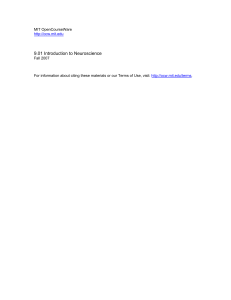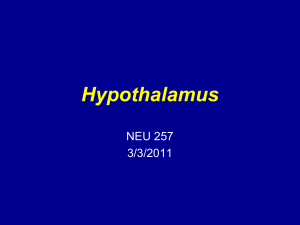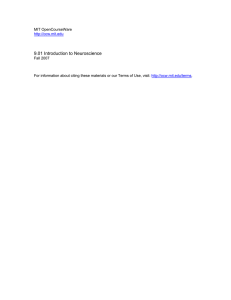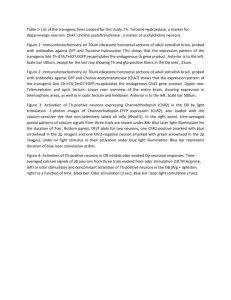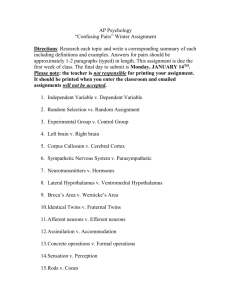9.01 Introduction to Neuroscience MIT OpenCourseWare Fall 2007
advertisement
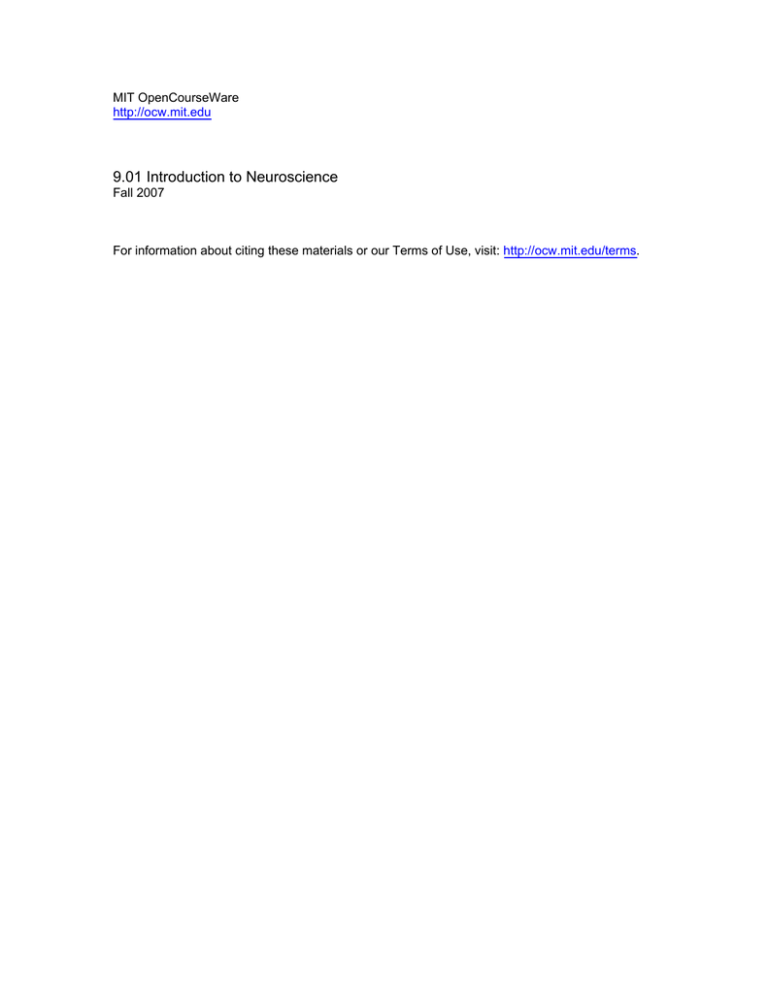
MIT OpenCourseWare http://ocw.mit.edu 9.01 Introduction to Neuroscience Fall 2007 For information about citing these materials or our Terms of Use, visit: http://ocw.mit.edu/terms. 9.01 FINAL EXAM REVIEW (PART 1): December 15, 2007 Outline of Part 1 of the Review Session: I. How to study for the final: th a. FINAL IS ON DEC. 20 FROM 9­12 IN DUPONT b. 2/3 of the final will be on new material = 30 multiple choice & ~2 long answers c. 1/3 of the final will be on old material = 15 multiple choice & ~2 long answers d. All lectures, assigned chapter readings and problem sets are fair game II. Brief review of material: a. CHEMICAL CONTROL OF THE BRAIN i. Lecture: 11/14 ii. Readings: Chapter 15 b. BRAIN DISORDERS AND ALZHEIMER’S DISEASE i. Lecture: 11/19 ii. Readings: Prof. Tsai PowerPoint Presentation (on MIT Server) & Chapter 22 c. EATING AND MOTIVATION (CHEM. CONTROL OF BRAIN II) i. Lecture: 11/26 ii. Reading: Chapter 16 d. ATTENTION i. Lecture: 12/03 ii. Reading: Prof. Desimone PowerPoint Presentation (on MIT Server) & Chapter 21 CHEMICAL CONTROL OF THE BRAIN Patterns of communication in the nervous system [figure 15.1; page 483] (1) Point­to­point systems • neurons synapse on a few neurons [ex. Dorsal thalamus to neocortex] (2) Hormones released by the secretory hypothalamus [pages 484­489] a. Secretory hypothalamus regulates homeostasis i. Homeostasis = maintenance of body’s internal environment (temp, blood volume, pressure, oxygen and glucose concentrations. b. Structure of secretory hypothalamus i. Three functional zones: lateral, medial, and periventricular ii. Periventricular zone: contains groups of cells: 1. SCN (suprachiasmatic nucleus) • synchronizes circadian rhythms 2. controls autonomic nervous system (ANS) 3. neurosecretory cells that innervate pituitary c. Control of posterior pituitary i. Magnocellular neurosecretory cells extend axons down into posterior pituitary ii. These cells release chemicals (neurohormones) directly into capillaries of posterior lobe (into the general circulation) ADH (vasopressin): Image removed due to copyright restrictions. oxytocin: 1 d. Control of anterior pituitary i. Note: anterior pituitary is an actual gland, while posterior pituitary is part of the brain ii. Parvocellular neurosecretory cells do not extend all the way into the lobe iii. The cells release hypophysiotropic hormones into the hypothalamopituitary portal circulation (capillaries that run the stalk of the pituitary and branch into anterior lobe) iv. The hypophysiotropic hormones bind to receptors in pituitary and activation of receptors causes cells to secrete or stop secreting hormones into the general circulation. ACTH: Image removed due to copyright restrictions. FSH & LH: TSH: PRL: GH: (3) Networks of neurons of ANS activate tissues in the body a. Perventricular zone hypothalamus also controls the ANS; nucleus of solitary tract b. Unlike the somatic motor system that controls targets via a monosynaptic pathway, ANS uses a disynaptic pathway c. Actions of ANS are usually carried out without conscious control and are typically multiple widespread and relatively slow (in comparison to somatic motor system). d. Two divisions: sympathetic vs. parasympathtic e. Enteric division (“little brain”) i. Neural system found in the lining of the esophagus, stomach, intestines, pancreas, and gallbladder. Controls the physiological process of transport and digestion of food. ii. Relatively independent of CNS, but supplementary control from sympathetic and parasympathetic. (ie. Increased activity of sympathetic nervous system • decreases digestive function during stress response) (4) Diffuse modulatory systems have divergent axonal projections a. Core system of small set of neurons (most from brainstem) influence many other neurons (axons make contact with more than 100,000 pathways). b. Not classical synapses; synapses release neurotransmitter into extracellular fluid and can diffuse to many neurons. 2 c. Psychoactive drugs: i. Hallucinogens – produces hallucinations 1. ex. LSD = agonist at presynaptic serotonin receptors; inhibits raphe nuclei firing ii. Stimulants 1. ex. Cocaine and amphetamine – blocks catecholamine uptake, works on DA and NE systems; increases alertness and decreases appetitie BRAIN DISORDERS AND ALZHEIMER’S DISEASE (1) Brain Disorders – Mental Illness Chapter 22 a. Anxiety Disorders: inappropriate expression of fear (or fear that is not adaptive) i. Biological Basis 1. stress response = hypothalamic­pituitary­adrenal (HPA) axis mediated response 2. regulation of HPA by amygdala – activation of amygdale stimulates CRH release 3. regulation of HPA by hippocampus – activation of hippocampus suppresses CRH release; feedback inhibition ii. Treatments 1. psychotherapy: repeated exposure to stimuli that causes anxiety 2. anxiolytic drugs: benzodiazepines (modulates GABA); SSRIs (selective serotonin reuptake inhibitor) b. Affective Disorder: mood disorders 3 i. Biological Basis 1. monoamine hypothesis – depression is result of deficit in NE and/or 5­HT diffuse modulatory system in brain 2. Diathesis­stress hypothesis (“diathesis” = predisposition for a disease) – depression is result of predisposition to disease and environmental factors; causes changes in HPA axis ii. Treatments 1. electroconvulsive therapy (ECT) 2. psychotherapy – patient overcome negative views of themselves and future 3. Antidepressant drugs – Tricyclic compounds, SSRIs, NE­selective reuptake inhibitors; MAOi 4. Lithium – highly effective in stabilizing mood of bipolar patients c. Schizophrenia: characterized by a loss of contact with reality and a disruption of thought, perception, mood and movement i. Symptoms 1. positive symptoms = presence of abnormal thoughts behaviors (ex. Delusions, hallucinations, disorganized speech, etc.) 2. negative symptoms = absence of normal responses (ex. Reduced expression of emotion, flatness of affect, poverty of speech, memory impairment, etc.) ii. Biological Basis 1. genes and environment 2. dopamine hypothesis – activation of DA receptors in mesocorticolimbic system 3. glutamate hypothesis – diminished activation of NMDA receptors iii. Treatments 1. neuroleptics – act on DA receptors, reduce positive symptoms, however side effects include Parkinson­like symptoms and tardive dyskinesia (2) Alzheimer’s Disease – Prof. Tsai’s PowerPoint presentation a. Pathological features of AD i. Brain atrophy ii. Amyloid plaques 1. Amyloid Precursor Protein (APP) • Aβ • Amyloid plaques Images removed due to copyright restrictions. 2. Genetics of AD: mutations in APP, secretase enzymes, and ApoE4 3. Example Experiment: found transgenic mice over expressing APP had memory impairment and accumulated a compound called Aβ*56 i. to test if Aβ*56 is important for memory impairment, gave young health rats purified Aβ*56 and found memory impairment iii. Neurofibrillary Tangles (NFT) 1. Tau • P­Tau (phosphorylated Tau) • Tangles 2. Tau is usually bound to microtubules. When phosphorylated by kinases (CDK5, etc.), Tau unbinds and aggregates into tangles. 3. Tangles also found in other diseases. 4. Staining NFT by silver staining, dyes, antibodies, etc. 5. Example exp.: neurodegeneration in an inducible mutant Tau transgenic mouse 4 EATING AND MOTIVATION (1) Three parts of hypothalamic regulation of homeostasis: a. Humoral response: hypothalamic neurons respond to sensory signals by stimulating or inhibiting release of pituitary hormones into bloodstream b. Viseromotor response: neurons in hypothalamus respond to sensory signals by adjusting balance of sympathetic and parasympathetic outputs of ANS c. Somatic motor response: lateral hypothalamic neurons inciting an appropriate somatic motor behavioral response (ex. Generating warmth by moving) (2) Long­term regulation of feeding behavior a. Anabolism = the assembly of macromolecules such as glycogen and triglycerides from simple precursors b. Catabolism = process of breaking down complex macromolecules c. Lipostatic hypothesis = a hypothesis prosing that body fat is maintained homeostatically at a specific level i. Must be communication between adipose tissue to the brain. ii. Hormone leptin (encoded by ob gene) is released by adipocytes (fat cells) and regulates body mass by directly acting on hypothalamic neurons that decrease appetite and increase energy expenditure. d. Lateral hypothalamic syndrome = lesions of lateral hypothalamus lead to anorexia e. Ventromedial hypothalamic syndrome = lesions of ventromedial hypo. lead to obesity f. Effects of elevated leptin • inhibit feeding behavior (figure 16.8, p. 517) Anorectic peptides = peptides that diminish appetite (αMSH or CART) g. Effects of decreased leptin • stimulates feeding behavior (figure 16.9, p. 517) Orexigenic peptides = peptides that stimulate feeding behavior (NPY and AgRP) (3) Short­term regulation of feeding behavior a. Satiety signals = a factor that reduces the drive to eat without causing sickness i. Examples include gastric distention and cholecystokinin (CCK) released by the intestinal cells in response to food. b. Ghrelin = a peptide secreted by cells in the stomach that stimulates appetite by activating orexigenic neurons in the hypothalamus c. Insulin = a hormone released by the β cells of the pancreas; regulates blood glucose levels and important for anabolic and catabolic metabolism (4) Why do we eat? a. Electrical self­stimulation = electrical stimulation that an animal can voluntarily deliver to a portion of its brain (rat presses lever to give electrical stimulation) i. Repeated self­stimulation when stimulating electrode was placed in areas of medial forebrain bundle b. Dopamine – stimulation of dopamine axons in lateral hypothalamus produced food cravings; depletion of DA resulted in animals liking food, but don’t seek food. 5 c. Serotonin ­ abnormalities in brain serotonin regulation believed to contribute to eating disorders (5) Overview (know leptin, ghrelin, and insulin) Image removed due to copyright restrictions. ATTENTION The state of selectively processing simultaneous sources of information (1) Behavioral consequences of attention: a. Enhanced detection (experiment on p. 646) i. Observer looks at fixation point, then give a neutral, invalid or valid cue ii. Cueing to the correct side of where the target would appear made it easier to detect the flashed target iii. Covert shift in attention even though eyes don’t’ move b. Faster reaction times (experiment on p. 647) i. Attention can alter the speed of visual processing or the time it takes to make a decision to press the button (2) Neglect Syndrome: an attentional disorder a. Appears to ignore objects, people and sometimes his own body to one side of the center of gaze. Common w/ right hemisphere damage 6 (3) Physiological effects of attention: a. fMRI imaging of attention to location (p. 649­650) i. enhancement in detection and reaction time are selective for spatial location ii. pattern of brain activity move retinotopically: different areas of the brain light up depending on the location of the attended section b. PET imaging of attention to features (p.651) i. Same­different task; both selective­attention and divided­attention ii. Different areas of cortex had higher activity when different attributes of stimuli were being discriminated iii. Numerous cortical areas appear to be affected by attention and the greatest attention effects are seen “late” rather than “early” areas in the visual system c. Enhanced neuronal response in parietal cortex (p.652) i. a neuron in cortex responds to a target stimuli ii. the response is enhanced if the target presented is followed by a saccade to the target iii. enhancement is spatial selective b/c it is not seen if a saccade occurs in response to a stimulus not in the receptive field d. Receptive field change in Area V4: (p.654) i. difference in ease of detection at the attended and unattended locations is based on the higher activity evoked by effective stimuli at the attended location = location specificity Image removed due to copyright restrictions. (4) How is attention directed? a. Pulvinar nucleus: structure in thalamus in which lesions result in abnormally show responses to stimuli on the contralateral side b. Frontal eye fields (FEF): cortical area that is involved in the production of saccadic eye movements and may play a role in the guidance of attention i. has motor fields = small areas in visual field ii. if significant stimulation passes through FEF, then eyes rapidly make a saccade to the motor field of the stimulate neuron iii. FEF stimulation mimics both the physiological and behavioral effects of attention ­­ end of part I ­­ 7

